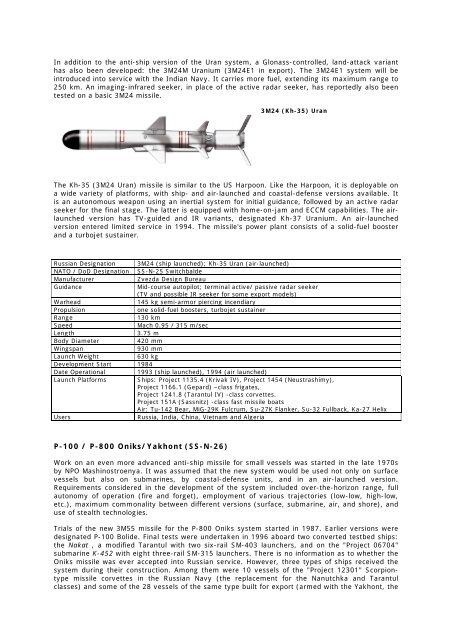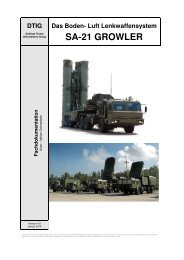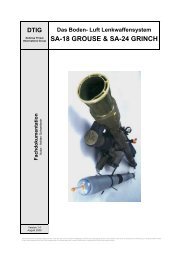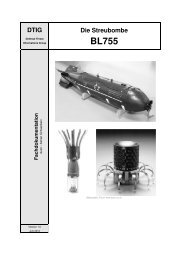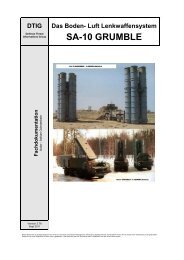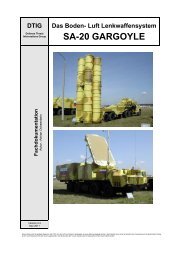RUSSIAN/SOVIET SEA-BASED ANTI-SHIP MISSILES Specia ... - DTIG
RUSSIAN/SOVIET SEA-BASED ANTI-SHIP MISSILES Specia ... - DTIG
RUSSIAN/SOVIET SEA-BASED ANTI-SHIP MISSILES Specia ... - DTIG
You also want an ePaper? Increase the reach of your titles
YUMPU automatically turns print PDFs into web optimized ePapers that Google loves.
In addition to the anti-ship version of the Uran system, a Glonass-controlled, land-attack variant<br />
has also been developed: the 3M24M Uranium (3M24E1 in export). The 3M24E1 system will be<br />
introduced into service with the Indian Navy. It carries more fuel, extending its maximum range to<br />
250 km. An imaging-infrared seeker, in place of the active radar seeker, has reportedly also been<br />
tested on a basic 3M24 missile.<br />
3M24 (Kh-35) Uran<br />
The Kh-35 (3M24 Uran) missile is similar to the US Harpoon. Like the Harpoon, it is deployable on<br />
a wide variety of platforms, with ship- and air-launched and coastal-defense versions available. It<br />
is an autonomous weapon using an inertial system for initial guidance, followed by an active radar<br />
seeker for the final stage. The latter is equipped with home-on-jam and ECCM capabilities. The airlaunched<br />
version has TV-guided and IR variants, designated Kh-37 Uranium. An air-launched<br />
version entered limited service in 1994. The missile's power plant consists of a solid-fuel booster<br />
and a turbojet sustainer.<br />
Russian Designation 3M24 (ship launched); Kh-35 Uran (air-launched)<br />
NATO / DoD Designation SS-N-25 Switchbalde<br />
Manufacturer Zvezda Design Bureau<br />
Guidance Mid-course autopilot; terminal active/ passive radar seeker<br />
(TV and possible IR seeker for some export models)<br />
Warhead 145 kg semi-armor piercing incendiary<br />
Propulsion one solid-fuel boosters, turbojet sustainer<br />
Range 130 km<br />
Speed Mach 0.95 / 315 m/sec<br />
Length 3.75 m<br />
Body Diameter 420 mm<br />
Wingspan 930 mm<br />
Launch Weight 630 kg<br />
Development Start 1984<br />
Date Operational 1993 (ship launched), 1994 (air launched)<br />
Launch Platforms Ships: Project 1135.4 (Krivak IV), Project 1454 (Neustrashimy),<br />
Project 1166.1 (Gepard) –class frigates,<br />
Project 1241.8 (Tarantul IV) -class corvettes.<br />
Project 151A (Sassnitz) -class fast missile boats<br />
Air: Tu-142 Bear, MiG-29K Fulcrum, Su-27K Flanker, Su-32 Fullback, Ka-27 Helix<br />
Users Russia, India, China, Vietnam and Algeria<br />
P-100 / P-800 Oniks/Yakhont (SS-N-26)<br />
Work on an even more advanced anti-ship missile for small vessels was started in the late 1970s<br />
by NPO Mashinostroenya. It was assumed that the new system would be used not only on surface<br />
vessels but also on submarines, by coastal-defense units, and in an air-launched version.<br />
Requirements considered in the development of the system included over-the-horizon range, full<br />
autonomy of operation (fire and forget), employment of various trajectories (low-low, high-low,<br />
etc.), maximum commonality between different versions (surface, submarine, air, and shore), and<br />
use of stealth technologies.<br />
Trials of the new 3M55 missile for the P-800 Oniks system started in 1987. Earlier versions were<br />
designated P-100 Bolide. Final tests were undertaken in 1996 aboard two converted testbed ships:<br />
the Nakat , a modified Tarantul with two six-rail SM-403 launchers, and on the "Project 06704"<br />
submarine K-452 with eight three-rail SM-315 launchers. There is no information as to whether the<br />
Oniks missile was ever accepted into Russian service. However, three types of ships received the<br />
system during their construction. Among them were 10 vessels of the "Project 12301" Scorpiontype<br />
missile corvettes in the Russian Navy (the replacement for the Nanutchka and Tarantul<br />
classes) and some of the 28 vessels of the same type built for export (armed with the Yakhont, the


